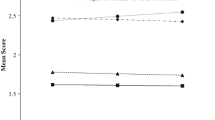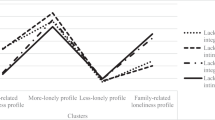Abstract
Loneliness is a crucial part of people’s experience in the transition to adulthood. Several developmental tasks, such as the separation/individuation process and exploration in the interpersonal domains connected with identity acquisition, lead adolescents to seek solitary experiences. Adolescents are involved in the redefinition of their relationships with parents and peers, moving away from their dependence on the family. The aim of the present study is to assess the effects of two aspects of autonomy: emotional autonomy (separation and detachment) and autonomous motivation for solitary behavior, on parent- and peer-related loneliness during adolescence. The participants were 977 adolescents (447 males and 530 females), aged between 14 and 20 years (M = 16.31; SD = 1.57), recruited from Italian high schools. The Italian versions of the Loneliness and Aloneness Scale for Children and Adolescents, of the Emotional Autonomy Scale and of the Frequency of and Autonomy for Solitary and Interpersonal Behavior scale were administered to each participant. Structural equation models and path analysis indicate the effects of separation–individuation process dimensions both on parent- and peer-related loneliness. Specific differences emerge between the two dimensions of loneliness. Peer-related loneliness is more influenced by autonomous motivation than is parent-related loneliness, and controlled motivation mediates its relationship with separation. The relationships among the constructs are discussed in the light of the separation–individuation process and with regard to the prevention of maladaptive outcomes.


Similar content being viewed by others
References
Axelsson, L., & Ejlertsson, G. (2002). Self-reported health, self-esteem and social support among unemployed young people: A population-based study. International Journal of Social Welfare, 11, 111–119.
Beiswenger, K. L. (2008). Autonomy for solitary and interpersonal behavior in adolescence: Exploring links with peer relatedness, well-being, and social coping. Worchester: Clark University Press.
Beiswenger, K. L., & Grolnick, W. S. (2010). Interpersonal and intrapersonal factors associated with autonomous motivation in adolescents’ after-school activities. Journal of Early Adolescence, 3, 369–394.
Berzonsky, M. D., & Neimeyer, G. J. (1994). Ego identity status and identity processing orientation: The moderating role of commitment. Journal of Research in Personality, 28(4), 425–435.
Beyers, W., Goossens, L., van Calster, B., & Duriez, B. (2005). An alternative substantive factor structure for the emotional autonomy scale. European Journal of Psychological Assessment, 21, 147–155.
Blos, P. (1967). The second individuation process of adolescence. Psychoanalytic Study of the Child, 29, 162–186.
Blos, P. (1979). The adolescent passage. Madison: International Universities Press.
Cacioppo, J. T., & Hawkley, L. C. (2009). Perceived social isolation and cognition. Trends in Cognitive Sciences, 13, 447–454.
Chircov, V., Ryan, R. M., Kim, Y., & Kaplan, U. (2003). Differentiating autonomy from individualism and independence: A self-determination theory perspective on internalization of cultural orientation and well-being. Journal of Personality and Social Psychology, 84, 97–109.
Chua, S. N., & Koestner, R. (2008). A self-determination theory perspective of the role of autonomy in solitary behavior. The Journal of Social Psychology, 148(5), 645–647.
Corsano, P., Majorano, M., & Champretavy, L. (2006). Psychological well-being in adolescence: The contribution of interpersonal relations and experience of being alone. Adolescence, 41(162), 341–353.
Corsano, P., Majorano, M., Michelini, G., & Musetti, A. (2011). Solitudine e autodeterminazione in adolescenza [Loneliness and self-determination during adolescence]. Ricerche di Psicologia, 4, 473–498.
Corsano, P., Majorano, M., & Musetti, A. (2012). Emotional autonomy and separation process during adolescence. In Proceedings of the XV European Conference on Developmental Psychology (pp. 245–249). Bologna, Italy: Medimond.
Corsano, P., Majorano, M., & Musetti, A. (2014). Emotional autonomy profiles: Separation, detachment and loneliness during adolescence. In Proceedings of the XVI European Conference on Developmental Psychology (pp.43-47). Bologna, Italy: Medimond.
Csikszentmihalyi, M., & Larson, R. (1984). Being Adolescent. New York: Basic Books.
Deci, E. L., & Ryan, R. M. (1985). Intrinsic motivation and self-determination in human behavior. New York: Plenum Press.
Deci, E. L., & Ryan, R. M. (2008). Self-determination theory: A macro-theory of human motivation, development, and health. Canadian Psychology, 3, 182–185.
Erikson, E. H. (1968). Identity, youth and crisis. New York: Norton and Company.
Goossens, L. (2006a). Affect, emotion, and loneliness in adolescence. In A. Jackson & L. Goossens (Eds.), Handbook of adolescent development (pp. 51–70). New York: Psychology Press.
Goossens, L. (2006b). The many faces of adolescent autonomy: Parent-adolescent conflict, behavioral decision-making, and emotional distancing. In A. Jackson & L. Goossens (Eds.), Handbook of adolescent development (pp. 135–153). New York: Psychology Press.
Goossens, L., Lasgaard, M., Luyckx, K., Vanhalst, J., Mathias, S., & Masy, E. (2009). Loneliness and solitude in adolescence: A confirmatory factor analysis of alternative models. Personality and Individual Differences, 47(8), 890–894.
Goossens, L., & Marcoen, A. (1999). Adolescent loneliness, self-reflection, and identity from individual differences to developmental processes. In K. J. Rotenberg & S. Hymel (Eds.), Loneliness in childhood and adolescence (pp. 225–243). New York: Cambridge University Press.
Harris, R. A., Qualter, P., & Robinson, S. J. (2013). Loneliness trajectories from middle childhood to pre-adolescence: Impact on perceived health and sleep disturbance. Journal of Adolescence, 6, 1295–1304.
Hawkley, L. C., & Cacioppo, J. T. (2010). Loneliness matters: A theoretical and empirical review of consequences and mechanisms. Annals of Behavioral Medicine, 40, 218–227.
Heinrich, L. M., & Gullone, E. (2006). The clinical significance of loneliness: A literature review. Clinical Psychology Review, 26(6), 695–718.
Hu, L., & Bentler, P. M. (1999). Cutoff criteria for fit indexes in covariance structure analysis: Conventional criteria versus new alternatives. Structural Equation Modeling, 6(1), 1–55.
Hutton, A., & Cusack, L. (2013). The perspectives of young people on their use of alcohol and risks at school leavers festivals. Neonatal Pediatric and Child Health Nursing, 16(3), 16–20.
Ingoglia, S. (2001). Contributo alla validazione dell’“Emotional Autonomy Scale” di Steinberg e Silverberg su una popolazione italiana [An Italian application of the “Emotional Autonomy Scale” of Steinberg and Silverberg]. Palermo: Edizioni Grifo.
Jones, A. C., Schinka, K. C., van Dulmen, M. H. M., Bossarte, R. M., & Swahn, M. H. (2011). Changes in loneliness during middle childhood predict risk for adolescent suicidality indirectly through mental health problems. Journal of Clinical Child and Adolescent Psychology, 40, 818–824.
Koepke, S., & Denissen, J. J. A. (2012). Dynamics of identity development and separation-individuation in parent–child relationships during adolescence and emerging adulthood–A conceptual integration. Developmental Review, 32, 67–88.
Kroger, J. (1998). Adolescence as a second separation–individuation process: Critical review of an object relations approach. In E. E. A. Skoe & A. L. von der Lippe (Eds.), Personality development in adolescence: A cross-national and life span perspective (pp. 172–192). London: Routledge.
Ladd, G. W., & Ettekal, I. (2013). Peer-related loneliness across early to late adolescence: Normative trends, intra-individual trajectories, and links with depressive symptoms. Journal of Adolescence, 36(6), 1269–1282.
Laursen, B., & Hartl, A. C. (2013). Understanding loneliness during adolescence: Developmental changes that increase the risk of perceived social isolation. Journal of Adolescence, 36(6), 1261–1268.
Luyckx, K., Goossens, L., Rassart, J., Apers, S., Vanhalst, J., & Moons, P. (2014). Parental support, internalizing symptoms, perceived health status, and quality of life in adolescents with congenital heart disease: Influences and reciprocal effects. Journal of Behavioral Medicine, 37(1), 145–155.
Luyckx, K., Vansteenkiste, M., Goossens, L., & Duriez, B. (2009). Basic need satisfaction and identity formation: Bridging self-determination theory and process-oriented identity research. Journal of Counseling Psychology, 56(2), 276–288.
Maes, M., Klimstra, T., Van den Noortgate, W., & Goossens, L. (2014). The multidimensionality of loneliness: Factor structure and measurement invariance across gender and age groups. Journal of Child and Family Studies, 1, 1–9. doi:10.1007/s10826-014-9986-4.
Marcoen, A., Goossens, L., & Caes, P. (1987). Loneliness in pre-through late adolescence: Exploring the contributions of a multidimensional approach. Journal of Youth and Adolescence, 16, 561–577.
Marsh, H. W., Muthén, B., Asparouhov, T., Lüdtke, O., Robitzsch, A., Morin, A. J. S., & Trautwein, U. (2009). Exploratory structural equation modeling integrating CFA and EFA: Application to students’ evaluations of university teaching. Structural Equation Modeling, 16, 439–476.
Meleddu, M., & Scalas, L. F. (2002). Validazione di una versione italiana dell’Emotional Autonomy Scale [Validation of an Italian version of the Emotional Autonomy Scale]. Bollettino di Psicologia Applicata, 238, 43–56.
Melotti, G., Corsano, P., Majorano, M., & Scarpuzzi, P. (2006). An Italian application of the Louvain Loneliness Scale for Children and Adolescents (LLCA). TPM-Testing Psychometrics Methodology in Applied Psychology, 13(3), 237–255.
Morley, T. E., & Moran, G. (2011). The origins of cognitive vulnerability in early childhood: Mechanisms linking early attachment to later depression. Clinical Psychology Review, 31, 1071–1082.
Musetti, A., Corsano, P., Majorano, M., & Mancini, T. (2012). Identity processes and experience of being alone during late adolescence. International Journal of Psychoanalysis and Education, 1(8), 44–65.
Muthén, L.K., & Muthén, B.O. (1998–2008). MPlus Users Guide. 5th Edition. Los Angeles, CA: Muthén and Muthén.
Nelis, S. M., & Rae, G. (2009). Brief report: Peer attachment in adolescents. Journal of Adolescence, 32(2), 443–447.
Pace, U., & Zappulla, C. (2010). Relations between suicidal ideation, depression, and emotional autonomy from parents in adolescence. Journal of Child and Family Studies, 19(6), 747–756.
Palmonari, A. (Ed.). (2011). Psicologia dell’adolescenza [Adolescent psychology]. Bologna: Il Mulino.
Qualter, P., Brown, S. L., Rotenberg, K. J., Vanhalst, J., Harris, R. A., Goossens, L., et al. (2013). Trajectories of loneliness during childhood and adolescence: Predictors and health outcomes. Journal of Adolescence, 6, 1283–1293.
Roberts, R. E., Roberts, C. R., & Chen, Y. R. (1998). Suicidal thinking among adolescents with a history of attempted suicide. Journal of the American Academy of Child and Adolescent Psychiatry, 37, 1294–1300.
Ryan, R. M., & Lynch, J. (1989). Emotional autonomy versus detachment: Revisiting the vicissitudes of adolescence and young adulthood. Child Development, 60, 340–356.
Schinka, K. C., van Dulmen, M. H. M., Mata, A. D., Bossarte, R., & Swahn, M. H. (2013). Psychosocial predictors and outcomes of loneliness trajectories from childhood to early adolescence. Journal of Adolescence, 1–2, 105–118.
Silverberg, S. B., & Gondoli, D. M. (1996). Autonomy in adolescence: A contextualized perspective. In G. R. Adams, R. Montemayor, & T. P. Gullotta (Eds.), Psycho-social development during adolescence (pp. 12–61). Thousand Oaks: Sage.
Sletta, O., Valas, H., Skaalvik, E., & Sobstad, F. (1996). Peer relations, loneliness and self-perceptions in school-aged children. British Journal of Educational Psychology, 66, 431–445.
Soenens, B., & Vansteenkiste, M. (2005). Antecedents and outcomes of self-determination in 3 life domains: The role of parents’ and teachers’ autonomy support. Journal of Youth and Adolescence, 34, 589–604.
Steinberg, L., & Silverberg, S. (1986). The vicissitudes of autonomy in early adolescence. Child Development, 57, 841–851.
Teppers, E., Klimstra, T. A., Van Damme, C., Luyckx, K., Vanhalst, J., & Goossens, L. (2014). Personality traits, loneliness, and attitudes toward aloneness in adolescence. Journal of Social and Personal Relationships, 30, 1043–1063.
van Den Broeck, A., Vansteenkiste, M., De Witte, H., & Lens, W. (2008). Explaining the relationships between job characteristics, burnout and engagement: The role of basic psychological need satisfaction. Work and Stress, 22, 277–294.
van Dulmen, M. H. M., & Goossens, L. (2013). Loneliness trajectories. Journal of Adolescence, 36(6), 247–1249.
van Roekel, E., Scholte, R. H. J., Verhagen, M., Goossens, L., & Engels, R. C. M. E. (2010). Loneliness in adolescence: Genex environment interactions involving the serotonin transporter gene. Journal of Child Psychology and Psychiatry and Allied Disciplines, 51, 747–754.
Vanhalst, J., Luyckx, K., & Goossens, L. (2014). Experiencing loneliness in adolescence: A matter of individual characteristics, negative peer experiences, or both? Social Development, 23, 1251–1260.
Vanhalst, J., Luyckx, K., Raes, F., & Goossens, L. (2012). Loneliness and depressive symptoms: The mediating and moderating role of uncontrollable ruminative thoughts. The Journal of Psychology, 1–2, 259–276.
Vanhalst, J., Luyckx, K., Scholte, R. H. J., Engels, R. C. M. E., & Goossens, L. (2013). Low Self-Esteem as a risk factor for loneliness in adolescence: Perceived-but not actual-social acceptance as an underlying mechanism. Journal of Abnormal Child Psychology, 41, 1067–1081.
Zimmer-Gembeck, M. J., & Collins, W. A. (2003). Autonomy development during adolescence. In G. R. Adams & M. D. Berzonsky (Eds.), Blackwell Handbook of Adolescence (pp. 175–204). Malden: Blackwell.
Author information
Authors and Affiliations
Corresponding author
Rights and permissions
About this article
Cite this article
Majorano, M., Musetti, A., Brondino, M. et al. Loneliness, Emotional Autonomy and Motivation for Solitary Behavior During Adolescence. J Child Fam Stud 24, 3436–3447 (2015). https://doi.org/10.1007/s10826-015-0145-3
Published:
Issue Date:
DOI: https://doi.org/10.1007/s10826-015-0145-3




